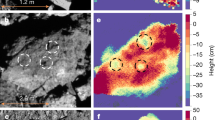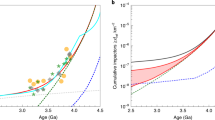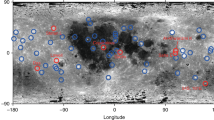Abstract
Impact craters are the most obvious indication of asteroid impacts, but craters on Earth are quickly obscured or destroyed by surface weathering and tectonic processes1. Earth’s impact history is inferred therefore either from estimates of the present-day impactor flux as determined by observations of near-Earth asteroids, or from the Moon’s incomplete impact chronology2,3,4. Asteroids hitting Earth typically vaporize a mass of target rock comparable to the projectile’s mass. As this vapour expands in a large plume or fireball, it cools and condenses into molten droplets called spherules5. For asteroids larger than about ten kilometres in diameter, these spherules are deposited in a global layer. Spherule layers preserved in the geologic record accordingly provide information about an impact even when the source crater cannot be found1. Here we report estimates of the sizes and impact velocities of the asteroids that created global spherule layers. The impact chronology from these spherule layers reveals that the impactor flux was significantly higher 3.5 billion years ago than it is now. This conclusion is consistent with a gradual decline of the impactor flux after the Late Heavy Bombardment.
This is a preview of subscription content, access via your institution
Access options
Subscribe to this journal
Receive 51 print issues and online access
$199.00 per year
only $3.90 per issue
Buy this article
- Purchase on Springer Link
- Instant access to full article PDF
Prices may be subject to local taxes which are calculated during checkout

Similar content being viewed by others
References
Simonson, B. M. & Glass, B. P. Spherule layers—records of ancient impacts. Annu. Rev. Earth Planet. Sci. 32, 329–361 (2004)
Ivanov, B. A. & Hartmann, W. K. In Treatise on Geophysics Vol. 10 Planets and Moons (ed. Schubert, G. ). 202–242 (Elsevier, 2007)
Le Feuvre, M. & Wieczorek, M. A. Nonuniform cratering of the Moon and a revised crater chronology of the inner Solar System. Icarus 214, 1–20 (2011)
Stuart, J. S. & Binzel, R. P. Bias-corrected population, size distribution, and impact hazard for the near-Earth objects. Icarus 170, 295–311 (2004)
Johnson, B. C. & Melosh, H. J. Formation of spherules in impact produced vapor plumes. Icarus 217, 416–430 (2012)
Raizer, Y. P. Condensation of a cloud of vaporized matter expanding in vacuum. Sov. Phys. JETP 37, 1229–1235 (1960)
Melosh, H. J. & Vickery, A. M. Melt droplet formation in energetic impact events. Nature 350, 494–497 (1991)
O’Keefe, J. D. & Ahrens, T. J. The interaction of the Cretaceous/Tertiary extinction bolide with the atmosphere, ocean, and solid Earth. Geol. Soc. Am. Spec. Pap. 190, 103–120 (1982)
Smit, J. The global stratigraphy of the Cretaceous-Tertiary boundary impact ejecta. Annu. Rev. Earth Planet. Sci. 27, 75–113 (1999)
Alvarez, L. W., Alvarez, W., Asaro, F. & Michel, H. V. Extraterrestrial cause for the Cretaceous-Tertiary extinction. Science 208, 1095–1108 (1980)
Collins, G. S., Melosh, H. J., Morgan, J. V. & Warner, M. R. Hydrocode simulations of Chicxulub crater collapse and peak-ring formation. Icarus 157, 24–33 (2002)
Kyte, F. T., Shukolyukov, A., Lugmair, G. W., Lowe, D. R. & Byerly, G. R. Early Archean spherule beds: chromium isotopes confirm origin through multiple impacts of projectiles of carbonaceous chondrite type. Geology 31, 283–286 (2003)
Lowe, D. R. et al. Spherule beds 3. 47–3. 24 billion years old in the Barberton Greenstone Belt, South Africa: a record of large meteorite impacts and their influence on early crustal and biological evolution. Astrobiology 3, 7–48 (2003)
Yancey, T. E. & Guillemette, R. N. Carbonate accretionary lapilli in distal deposits of the Chicxulub impact event. Geol. Soc. Am. Bull. 120, 1105–1118 (2008)
Minton, D. A. & Malhotra, R. Dynamical erosion of the asteroid belt and implication for large impacts in the inner Solar System. Icarus 207, 744–757 (2010)
Lowe, D. R. & Byerly, G. R. Did LHB end not with a bang but a whimper? The geologic evidence. 41st Lunar Planet. Sci. Conf. 2563 (2010)
Gomes, R., Levinson, H. F., Tsiganis, K. & Morbidelli, A. Origin of the cataclysmic Late Heavy Bombardment period of the terrestrial planets. Nature 435, 466–469 (2005)
Bottke, W. F. et al. An Archaean heavy bombardment from a destabilized extension of the asteroid belt. Naturehttp://dxdoi.org/10.1038/nature10967 (this issue).
Rasmussen, B. & Koeberl, C. Iridium anomalies and shocked quartz in a Late Archean spherule layer from Pilbara craton: new evidence for a major asteroid impact at 2. 63 Ga. Geology 32, 1029–1032 (2004)
Kohl, I., Simonson, B. M. & Berke, M. Diagenetic alteration of impact spherules in the Neoarchean Monteville layer, South Africa. Geol. Soc. Am. Spec. Pap. 405, 57–73 (2006)
Goderis, S. et al. Geochemical correlation of two late Archean impact spherule layers between South Africa and Western Australia: the Paraburdoo-Reivilo link. 43rd Lunar Planet. Sci. Conf. 1882 (2011)
Hassler, S. W., Simonson, B. M., Sumner, D. Y. & Bodin, L. Paraburdoo spherule layer (Hamersley Basin, Western Australia): distal ejecta from the fourth large impact near the Archean-Proterozoic boundary. Geology 39, 307–310 (2011)
Simonson, B. M. et al. Geochemistry of 2. 63–2. 49 Ga impact spherule layers and implications for stratigraphic correlations and impact processes. Precambr. Res. 175, 51–76 (2009)
Simonson, B. M. Geological evidence for a strewn field of impact spherules in the early Precambrian Hamersley basin of Western Australia. Geol. Soc. Am. Bull. 104, 829–839 (1992)
Glikson, A. & Allen, C. Iridium anomalies and fractionated siderophile element patterns in impact ejecta, Brockman Iron Formation, Hamersley basin, Western Australia: evidence for a major asteroid impact in simatic crustal regions of the early Proterozoic Earth. Earth Planet. Sci. Lett. 220, 247–264 (2004)
Simonson, B. M., Sumner, D. Y., Beukes, N. J., Johnson, S. & Gutzmer, J. Correlating multiple Neoarchean-Paleoproterozoic impact spherule layers between South Africa and Western Australia. Precambr. Res. 169, 100–111 (2009)
Chadwick, B., Claeys, P. & Simonson, B. New evidence for a large Palaeoproterozoic impact: spherules in a dolomite layer in the Ketilidian orogeny, South Greenland. J. Geol. Soc. Lond. 158, 331–340 (2001)
Shukolyukov, A. & Lugmair, G. W. Isotopic evidence for the Cretaceous-Tertiary impactor and its type. Science 282, 927–930 (1998)
Glass, B. P., Koeberl, C., Blum, J. D. & McHugh, M. G. Upper Eocene tektite and impact ejecta layer on the continental slope off New Jersey. Meteorit. Planet. Sci. 33, 229–241 (1998)
Kyte, F. T., Shukolykov, A., Hildebrand, A. R., Lugmair, G. W. & Hanova, J. Chromium-isotopes in Late Eocene impact spherules indicate a likely asteroid belt provenance. Earth Planet. Sci. Lett. 302, 279–286 (2011)
Acknowledgements
We thank B. Simonson and C. Chapman, whose comments improved this work. We acknowledge support from NASA.
Author information
Authors and Affiliations
Contributions
B.C.J. developed the methods used in this work with the guidance of H.J.M. Both authors contributed to the conclusions presented in this work.
Corresponding author
Ethics declarations
Competing interests
The authors declare no competing financial interests.
Supplementary information
Supplementary Information
This file contains Supplementary Text and Data, an additional reference and Supplementary Figure 1. (PDF 464 kb)
PowerPoint slides
Rights and permissions
About this article
Cite this article
Johnson, B., Melosh, H. Impact spherules as a record of an ancient heavy bombardment of Earth. Nature 485, 75–77 (2012). https://doi.org/10.1038/nature10982
Received:
Accepted:
Published:
Issue Date:
DOI: https://doi.org/10.1038/nature10982
This article is cited by
-
Integrated petrographic and geochemical analysis of the Langobard age pottery of Szólád, Western Hungary
Archaeological and Anthropological Sciences (2022)
-
Delayed and variable late Archaean atmospheric oxidation due to high collision rates on Earth
Nature Geoscience (2021)
-
Shock Metamorphic Features in the Archean Simlipal Complex, Singhbhum Craton, Eastern India: Possible Remnant of a Large Impact Structure
Journal of the Geological Society of India (2021)
-
Hypervelocity Impacts and Exposed Lithospheric Mantle: A Way to Recognize Large Terrestrial Impact Basins?
Journal of Earth Science (2019)
-
Cataclysm No More: New Views on the Timing and Delivery of Lunar Impactors
Origins of Life and Evolution of Biospheres (2017)
Comments
By submitting a comment you agree to abide by our Terms and Community Guidelines. If you find something abusive or that does not comply with our terms or guidelines please flag it as inappropriate.



